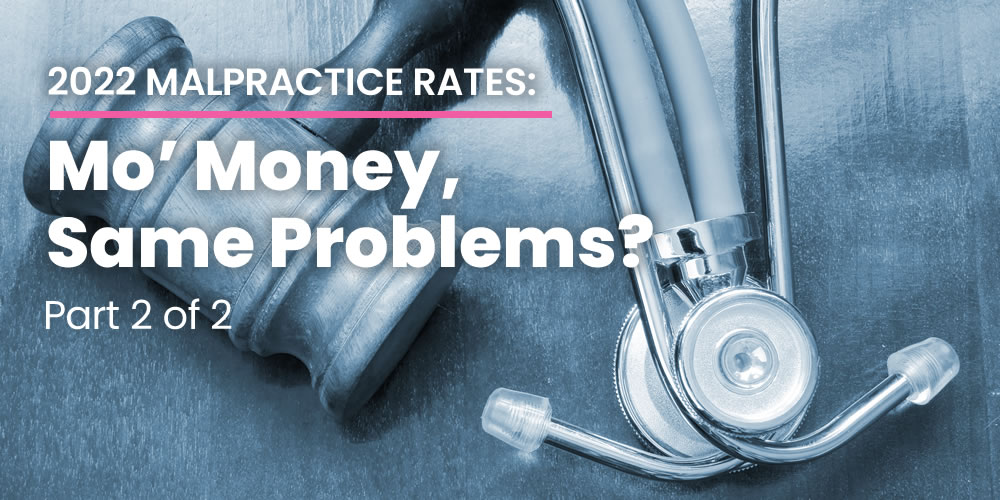This is Part 2 of our two-part series about the spike in medical malpractice insurance rates for 2022. In Part 1, we learned that rates have been increasing in recent years due to the number of severe claims, an uncertain market, and company mergers. Now, we cover the factors that determine your insurance rate and which doctors are hit hardest by malpractice suits.
Why Is Medical Malpractice Insurance So Expensive?
Securing the right medical malpractice liability coverage can make or break a clinical career. In a section of its website called “MedMal 101,” the malpractice insurance experts at Diederich Healthcare suggest that, while tapping into a knowledgeable insurance professional is critical, it’s also important to empower yourself with knowledge.
In a June 2020 article about understanding locum tenens contracts, attorney-authors Jack A. Gordon and Andrew E. Sarti (attorneys with Kent, Beatty, & Gordon, LLP) advised, “Medical malpractice insurance is a standard provision, but which party provides the coverage; the policy type; its term; the policy limits; tail coverage; and other important aspects vary widely. Even for the most prudent and skilled physicians, the threat of a malpractice suit is very real. This is why physicians must both understand and confirm the terms of malpractice coverage outlined in the locum tenens agreement.”
In its guide How Are Malpractice Premiums Calculated? Aegis Malpractice Solutions notes, “Malpractice insurance is one of the top expenses for a medical practice.” Over the next several pages, the company attempts to explain, in simple terms, what makes malpractice insurance coverage so pricey.
“Each insurance carrier has a unique set of guidelines that tells the underwriter how to price a risk. Premiums are generally calculated by determining the base rate (sometimes referred to as ‘the manual rate’) and then adding or subtracting from that to account for a number of risk factors.
“The 5 main things that affect your base rate are:
- Specialty
- Practice location
- Policy type¹
- Policy limits
- Effective date”
What Are the Odds?
“More than half of US doctors surveyed for Medscape’s 2021 Malpractice Report said they have been named in a malpractice lawsuit, with plastic surgery being the top specialty cited.” This is according to a recent article in Becker’s ASC Review,
Medscape surveyed 4,358 physicians in 29 specialties from May 21 to Aug. 28. [More than half of respondents (53%) said they’d practiced for more than 25 years, while only 15% of responding physicians said they’d practiced for 10 years or less.]”
Slightly more than half (51 percent) reported having been named in a malpractice lawsuit.
Specialty
“Percentage of physicians named in malpractice lawsuits by specialty (top 6)
Plastic surgery: 83%
General surgery: 83%
Orthopedics: 81%
Urology: 80%
OB-GYN: 79%
Specialized surgery: 74%”
“In most cases, large differences in premiums exist [among specialties] because the physician simply does not have coverage with the right carrier for their specialty,” according to Diederich Healthcare’s “MedMal 101”.
“Various insurance companies prefer different specialties as a result of their success in defending claims for those specialties. When a physician elects coverage with the company best suited for that physician’s specialty and geographical location, it results in very competitive premiums.”
Location
“Medical liability insurance premiums have begun an upward trend after holding more or less steady during the past decade, according to a new analysis (PDF) from the American Medical Association (AMA)
“In 2020, during the height of the COVID-19 pandemic, more than 30% of premiums reported in a survey of liability insurers increased from the previous year, the highest percentage since 2005.
“For a second consecutive year there has been an exceptional surge in the percentage of premiums with a year-to-year increase. Between 2010 and 2018, the share of premiums that increased maintained a somewhat stable pattern, ranging from 12% to 17%. In 2019, that proportion almost doubled to 26.5% and went up again in 2020 to 31.1%.
“According to the AMA analysis, ‘the responsiveness of premiums to changes in their determinants and external factors takes considerable time in the medical liability insurance market. Therefore, although some 2020 premiums may have been set after the onset of the [COVID-19] pandemic, it was still too early for them to be affected by it.’
“The AMA analysis identified the 14 states that had premium increases of 10% or more. Those states and their 2020 premium-increase percentages were:”
- Kentucky (29.6%)
- South Carolina (27.8%)
- Maryland (18.8%)
- Nebraska (16.7%)
- Oregon (16.7%)
- Montana (16.7%)
- Georgia (14.8%)
- Missouri (14.8%)
- New Hampshire (13.3%)
- Illinois (11.9%)
- Michigan (11.6%)
- Texas (9.2%)
- North Carolina (6.7%)
- Virginia (1.3%)
“The AMA report also finds striking differences in premiums for certain specialties by geography. For example, in 2020 some physicians in OB/GYN faced base premiums ranging from $49,804 in Los Angeles County, California to $205,380 in Miami-Dade County, Florida.
“ ‘Keeping medical liability premium growth in-check is imperative to ensure patient access to care is not jeopardized by unaffordable liability insurance costs that make it impossible for physicians to remain in practice,’ ” Dr. Bailey said. ‘This concern is particularly pressing given the negative impact that the COVID-19 pandemic has had on access and practice viability, as many physicians have had to suspend patient visits or elective procedures, and some have had to close their practices.’ ”
Loss Experience
The Federation of State Medical Boards (FSMB) reports that in 2017, there were almost 9,000 (8813) actions taken by state licensing boards against physicians nationwide, according to Physicians Practice.
“Contrary to common perception, many of these complaints did not stem from clear and unequivocal malpractice, fraud or misconduct issues.
“Because state medical boards do not restrict or impede any person or entity from filing a complaint against a physician, anyone–including a disgruntled former employee, contentious business partner or adversarial spouse filing for divorce–can trigger an investigative process that, ultimately, can prompt a medical board to discipline a physician.
“In addition, many state and federal laws mandate that hospitals, insurance carriers, law enforcement agencies, and local prosecutors report to a licensing board whenever a physician is arrested, has their hospital medical staff privileges suspended or restricted, or becomes the subject of an adverse judgment or settlement as a result of a medical malpractice lawsuit.”
Are doctors (and other advanced practice practitioners) viewed as “deep pockets” or what?
Legal Costs
Whether or not you’re found “guilty” in a lawsuit and have to pay damages, you’ll still have to defend yourself in court.
“Legal defense alone can cost tens of thousands of dollars; in most cases far more than the cost of malpractice coverage,” according to Physician Thrive’s Full Guide to Physicians Malpractice Insurance by Justin Nabity (last updated 3/26/2021). “In the rare instance that malpractice insurance isn’t a requirement, the pros of having it far outweigh the cons.
“The only con of having malpractice insurance is the cost of paying for it. This expense is minimal compared to the amount you could be on the hook for if a patient files a suit against you.”
Echoing MedScape’s 2021 survey data, the AMA reports that 34% of physicians will have a medical malpractice lawsuit filed against them during their careers. “The longer you practice, the more likely that becomes. About half of all physicians over the age of 55 have been sued at least once,” Nabity writes.
Nabity’s analysis of a 2018 National Practitioner Data Bank report shows plaintiffs who sued for medical malpractice received more than $4B, with an average payout of $348,065 per claim.
“Of all lawsuits filed, approximately 50% go to trial, although only about 5% result in a jury verdict,” Nabity says. “In most cases, malpractice claims end in a settlement, either before trial or during the trial proceedings.”
He notes that, even if a jury decides in your favor, you must pay for legal services and related costs, unless you have malpractice insurance to cover them.
One Locum Physician’s Experience
Vladimir Dzhashi, MD, aka “The Locum Tenens Guy,” was named in a malpractice lawsuit for the first time in 2018. Earlier this year he shared that this stressful experience prompted him to do some research, which reassured him he was far from alone among US physicians.
“The other revelation was that not every state is created equal and there are parts of the country that are literally a ‘hot mess’ when it comes to liability and others are as close to a ‘legal paradise’ as they can get.
“In fact, you are more than 10 times (!!!) likely to be sued in the “riskiest” state compared to the lowest risk state.”
The five worst states for malpractice liability risk, according to Dr. Dzashi’s research:
- New Jersey
- Louisiana
- Pennsylvania
- Florida
- New York
“New Jersey is the worst state in the country in terms of physician liability,” Dr. Dzhashi wrote. “There is no cap on noneconomic damages and the number of claims is extremely high.”
Regarding Louisiana’s second-worst position on the list, the per-diem-practicing hospitalist notes that, while the southern state has $500K cap on noneconomic damages AND a patient compensation fund, it’s “known to have one of worst liability climates in the country.”
Meanwhile, Pennsylvania has ‘no cap on noneconomic damages and some of the highest malpractice insurance premiums in the country.’
Dr. Dzhashi lists the five states with the lowest malpractice liability risk as:
- North Dakota
- Wisconsin
- Minnesota
- Hawaii
- North Carolina
Tort Reform Has Lowered Malpractice Insurance Costs
For the past decade or so, malpractice insurance premiums have either decreased or remained flat. And that’s partly because more and more states have passed different levels of tort reform.
These laws started being put into place in various states in the early 2000s. Since then, physicians have seen much more stable rates that do not increase year after year.
With tort reform laws, states put a cap on the amount of money judges can order physicians to pay in a malpractice suit. And with this reform, the cost of malpractice insurance has decreased a bit.
The tort laws vary from state to state, but they serve as a way of limiting how much a jury awards a patient if they win their suit.
The bottom line is this: Physicians working in states with strict tort reform laws tend to pay less than those working in states that haven’t yet put those laws in place.
How Expensive Is Malpractice Insurance?
On average, medical malpractice insurance costs $7,500 per year.
Physician Thrive’s Nabity reports² that, “Malpractice insurance costs work out to about 3.2% of most physicians’ incomes.
“Surgeons typically pay between $30K and $50K in annual premiums. Other medical professionals typically pay between $4K and $12K per year, depending on their specialty and area(s) of expertise.
“And while malpractice insurance can be a hefty monthly bill for surgeons, obstetricians tend to pay the highest rates of all: OB/GYNs in Long Island, NY, pay as high as $214,999 per year.”
The Bigger Picture
In a news release issued in mid-November, Fifth Avenue Healthcare Services explained:
“Medical malpractice insurance premiums are seeing increases of 10-15% on average in Oklahoma. Rising medical malpractice insurance premiums in Oklahoma can be attributed to two factors:
- Rising amounts of jury verdicts
- Increases in re-insurance costs
“The jury verdicts are not exclusive to Oklahoma. This is a nationwide trend over the last few years that has finally caught up to the carriers’ bottom lines and are showing up as underwriting losses. Reinsurance premiums are also a nationwide trend.
“Generally, all insurance risks end up ‘pooled’ with other risks such as hurricanes, wildfires and civil unrest.”
SO…When you wonder why medical malpractice insurance is so expensive for 2022, consider the explanation you’ve just read. And then take a look back at how many of the latter types of losses we’ve witnessed over the past decade.
¹For a no-nonsense explanation of the main types of malpractice insurance policies, see Part 5, Section 2 of Locumpedia’s No-BS Guide to Locum Tenens, under the subhead “Malpractice Insurance.”
² https://physiciansthrive.com/malpractice-ins








